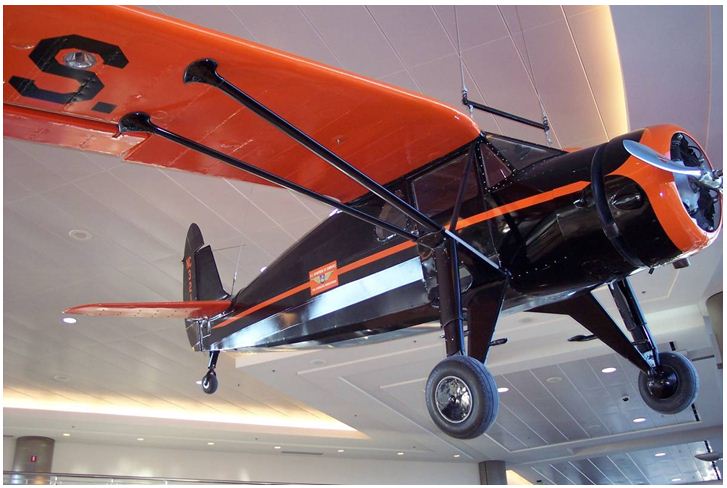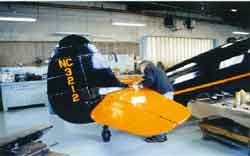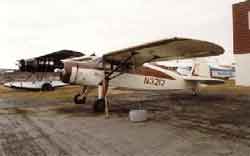1938 Fairchild 24 N3212



Displayed in the Ted Stevens International Airport Concourse C.



Displayed in the Ted Stevens International Airport Concourse C.
| Crew: | 1 pilot | |
|---|---|---|
| Passengers: | 3 | |
| Length: | 23 ft 10 in | 7.27 m |
| Wingspan: | 36 ft 4 in | 11.08 m |
| Height: | 7 ft 8 in | 2.34 m |
| Wing area: | 193 sq ft | 17.9 sq m |
| Empty Weight: | 1,813 lb | 822 kg |
| Max takeoff weight: | 2,882 lb | 1,307 kg |
| Powerplant: | Warner SS-50 | |
| 145 hp | 108 kW |
|
| Performance | ||
| Maximum Speed: | 124 mph (108 kn) | 200 km/h |
| Range: | 404 nmi (465 miles) | 748 km |
| Ceiling: | 12,700 ft | 3,900 m |
N3212 (NC32) FAIRCHILD 24G S/N 2933
The Fairchild Model 24 first flew in 1932, by 1935 more Model
24s had been sold than any other aircraft in its class; over 1,980
Model 24s were built by the time production ceased in 1947.
The model 24G was introduced in 1937, the largest customer of
the Model 24G was the U.S Government’s Bureau of Air Commerce, which is
now known as the Federal Aviation Administration (FAA). The Bureau
originally ordered 26 Model Gs, however, in 1940, records indicate the
Bureau owned 20 Model 24Gs, 8 Model 24M-9s and 1 Model 24GS-G. You
could purchase a Model 24G in 1937, complete, for $5,890.00.
While there is no record of N3212 having been in Alaska prior to
1978, it is representative of the many that did serve here, both as
personnel transportation and with various Air Taxi operators; such as
Alaska Coastal Airlines, in Juneau, Mirow Air Service, in Nome, they
were also flown by the Civil Aeronautics Commission and the Alaska
Game Commission.
There are currently 405 Model 24s registered in the U.S., 11 of
which are in Alaska.
27 April 1938 - Original bill of sale transferring title to the Dept.
of Commerce, Bureau of Air Commerce, Washington D.C. The date of
manufacture is listed as April 1938. NC 32 was assigned as the
aircraft identification Mark.
27 April 1938 - The first Aircraft License Authorization gives the
gross weight as 2,400 pounds, and the empty weight as 1,519. This form
shows a radio receiver (RCA AVR-7F) as weighing 40 pounds, no
transmitter was listed. It also states that the useful load is 381
pounds with full fuel, (60 gallons).
12 July 1938 - A wind driven generator was Installed at Love Field,
Dallas, TX. The weighed 9.5 pounds.
25 July 1939 - The wind driven generator was removed and an engine
driven generator installed.
20 January 1940 - A letter from the Civil Aeronautic Authority,
Assistant Chief, Records Division list, by S/N, 21 Fairchild model
24-G’s and 8 Model 24-M-9’s owned by the Civil Aeronautics Authority.
17 July 1941 - A Lear model UT-6 radio transmitter, weighing 39
pounds, was installed. This addition brought the weight of the radios
to 79 pounds, just for a receiver and a transmitter.
20 May 1944 - The aircraft was disassembled, inspected and all the
fabric was replaced. This was competed by the Spartan Aircraft
company, School of Aeronautics, Tulsa, OK.
8 September 1944 - A new engine was installed, this was also completed
by the Spartan Aircraft Company.
7 December 1944 - Repaired Inboard ribs of the right wing and
recovered both wings with grade A fabric.
3 September 1948 - Bill of Sale transferring title to New Mexico
Highland University, Vocational Dept, Las Vegas, NM. The sale price
was $7,000.00, minus 95% discount, for a total cost of $350.00.
24 September 1948 - Form ACA-195, Aircraft Status Change , states that
the aircraft was declared surplus, The ‘N’ number was changed to
NC32E. The various licenses that were issued when this aircraft was
new were comparable to the Airworthiness Certificates used today. The
identification number would change depending on what license was in
effect at the time; example, 32E, C32E, NC32E and it could be cancelled by the
Dept. of Commerce or the owner for various reasons. Only licensed
pilots could legally fly an aircraft with a letter prefix. If the
number had no letter prefix, as in 32E, then it was limited to
commercial operations wholly within one state and licensed pilots were
specifically prohibited from flying it while carrying persons or
property for hire. C and NC were commercial airplane licenses, R and
NR were restricted licenses and X and NX were experimental licenses.
These licenses were issued semi-annually.
10 September 1954 - Sold to John M. Haberl, Las Vegas, NM.
6 December 1954 - Sold to H.A. Jensen, Albuquerque, NM.
5 August 1955 - Sold to Wallace Gunn, Robert and Kurt Gottlieb,
Cubero, NM.
29 June 1956 - The top of the fuselage was recovered with grade A
fabric.
30 May 1958 - Sold to Kenneth R. McNeill, Bluewater, NM.
22 November 1959 - An ACA Form 337 documenting a left wing spar splice
and replacement of most of the fabric states that the work was done by
a deceased mechanic; He must have been awfully slow.
28 March 1960 - Sold to Leo Overturf, Oklahoma City, OK.
9 April 1960 - Sold to Kenneth L. McMillin, Oklahoma City, OK.
26 February1962 - Sold to Miles E. Westfall, Oklahoma City, OK.
29 May 1963 - Major repairs made to both wings. This could have been
from hail damage.
No Date - Letter requesting ‘N’ number change to N3200.
17 February 1967 - Assignment of Special Registration Mark N3212.
1 April 1968 - Sold to Ward Hallenberg, Wagoner, OK.
4 May 1968 - The aircraft was ground looped, damaging the right wing
and the wing tip.
10 June 1970 - Sold to Gordon E. Swann, Sandia, TX.
5 June 1973 - Sold to Donald G. Dickson, Victoria, TX.
28 August 1975 - The aircraft was stripped, inspected and recovered
with Stits Poly-fiber fabric, overhaul included new windows and
windshield.
27 March 1978 - Sold to Gilbert D. Scheff, Anchorage, AK.
26 December 1986 - Sold to the Air Museum, Anchorage, AK.
1 April 1991 - Sold to the Alaska Aviation Heritage Museum.
10 June 1996 - Repaired right aft spar by splicing in a new section.
Replaced the vertical fin rear spar, repaired the left wing trailing
edge ribs and the aircraft was recovered with poly fiber fabric.
15 January 1998 - The horizontal stabilizer was completely rebuilt,
with new spars and ribs made from Sitka Spruce.